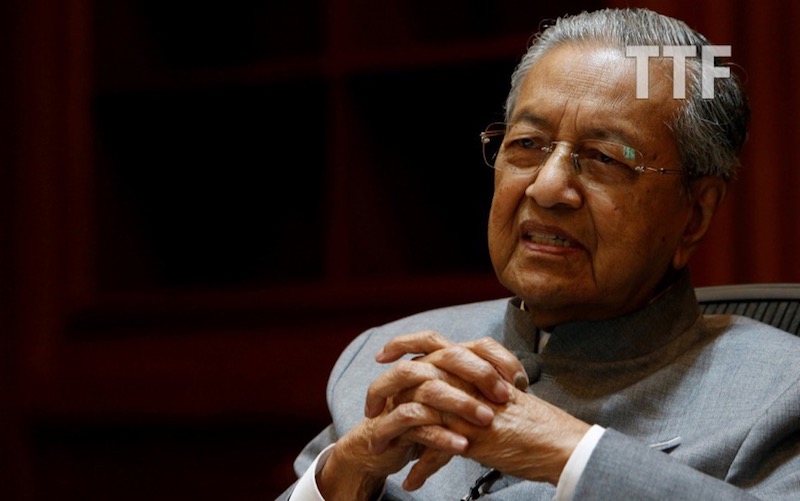
TTF: Mahathir said today that the government couldn’t make the Council of Eminent Persons (CEP)’s report public as some matters are still at the consultation stage.
What this means, is that a decision on the matter has yet to be reached as the government is still discussing the matter.
But this stood in stark contrast to what Deputy Minister in the Prime Minister’s Department Hanipa Maidin told the Dewan Rakyat yesterday.
According to him, the report was already classified under Official Secrets Act 1972 (OSA), meaning, the government had already reached consensus on the need to keep the report from being made public.
So who’s telling the truth?
To my recollection, the setting up of the CEP was not constitutional and was alleged to have been the result of a decision made by Mahathir himself in his personal capacity without consulting the Dewan Rakyat or the Malaysian Cabinet.
That immediately brings to question Hanipa’s claim that a report by the council was classified by the GoM under the OSA.
Not only is the report none of the GoM’s business, the OSA is typically reserved for documents belonging to the Government of Malaysia and (or) institutions and agencies that fall within statutes of law defined by the Federal Constitution of Malaysia.
Is Dr M going to now say that the CEP is answerable to the Cabinet?
A lot of what’s going on seems reminiscent of what took place back in the mid eighties.
On the 15th of February 2019, I wrote:
In 1980, Bank Bumiputera Malaysia Bhd (BBMB) was receiving RM50 million a month from Petronas as part of an agreement to stock the bank’s coffers. To facilitate offshore transactions, the bank undertook to establish Bumiputera Malaysia Finance (BMF) in Hong Kong before channelling parts of the RM50 million to several intermediary concerns.
Sometime that year, the (then) Minister of Finance, Tengku Razaleigh Hamzah, got the then chairman of BMF, the late Lorrain Esme Osman, to approve borrowings worth USD292 million to a Hong Kong based entity. The money was channeled in four tranches between the 19thof December 1979 and the 25th of June 1980.
It was soon discovered that the then owner of UMBC, Chang Ming, had facilitated the transfer of yet another USD50 million from UMBC to a BBMB subsidiary in Bahrain. In the years that followed, both BBMB and BMF approved a series of loans to the tune of RM2.5 billion to a Hong Kong registered entity to facilitate investment into the territory’s booming property market. However, in 1983, that entity, the Carrian Group, went bust after the property bubble burst and left both BBMB and BMF unable to recover the loans.
A Committee of Inquiry was quickly called into the affair and discovered multiple violations in banking protocols. Not only did BBMB and BMF fail to make certain entries into their books, many transactions were not in sync and pointed to elements of fraud. But the biggest elephant in the room was the murder of senior BBMB auditor Jalil Ibrahim, who, according to the information I have, unearthed enough evidence to end the career of a minister and several other government officials.
An RCI into the scandal would have risked disclosure of Mahathir’s role in the whole affair and the true identity of the man who ordered Jalil’s murder, an individual from the Ministry of Finance (something that will follow me to my grave).
To prevent disclosure, Mahathir told Cabinet that because BMF was registered in Hong Kong, a Committee of Inquiry would be more appropriate than an RCI.
Truth is, he preferred an NCI over an RCI because an NCI lacks jurisdiction to subpoena persons or confidential documents and does not grant legal immunity to investigators against possible cases of defamation.
He then got the late Tan Sri Ahmad Noordin Zakaria to lead the committee.
Mahathir believed that Noordin would never reveal what was not meant to be revealed as the latter was known to be an overly cautious man.
But not only did the Auditor-General dig as deep as he could into the scandal, he insisted that the NCI report be made public “as the people have the right to know.”
When Mahathir refused to entertain the idea, Noordin made a very public plea for disclosure by insisting that the Prime Minister made available all of the committee’s findings even if it brought shame to the GoM.
The very next day, Mahathir said this:
“If damage is done to the credibility or credit-worthiness of BBMB”, as a result of publishing the report, “the bank will be fully justified in suing you for damages.”
But not only did Noordin agree to take full responsibility, so did one other NCI member, a lawyer by the name of Chooi Mun Sou.
Seeing no alternative, Mahathir quickly got his men to attach a RM250 price tag to the report before agreeing to make it public. Now, imagine getting someone to purchase a copy of the RCI report into the Nineties Forex Scandal at RM1,250, which roughly is what the NCI report would have been worth today.
Back then, the average Malaysian would likely have found the price too hefty and would probably have given the report a miss.
Still, just to be sure nobody would find a copy of it anywhere, Daim quickly instructed his men to snap up most copies almost as soon as they were published.
To appease members of public, Mahathir got the GoM to release a ‘white paper’ that was so scant on details, Aliran Monthly insisted that it was a “white wash” and not the white paper.
But according to Mahathir, the release was proof that he had done no wrong and that the GoM was sincere in getting to the bottom of things.
Are we looking at yet another episode of “the Noordin Report” all over again?
LANGKAWI: The government cannot make the Council of Eminent Persons (CEP)’s report public as some matters are still at the consultation stage, said Prime Minister Tun Dr Mahathir Mohamad.
He said although he was aware that the government would be accused of not being transparent because of this, such stand was necessary as more time was needed before any decision could be made.
“I don’t know what it is that we can’t tell, as we have revealed almost everything, but there are some matters under consultations and we cannot reveal what we are negotiating until a decision has been reached,” he told a press conference here today.
He had earlier attended Permodalan Kedah Bhd (PKB) silver jubilee celebration and opened Hotel Adya Chenang here.
Dr Mahathir was asked to comment on calls by various parties for the government to make the report public as it is now placed under the Official Secrets Act 1972.
Dr Mahathir also said that he was aware that some Malaysians were not bothered by the damage done by former prime minister Datuk Seri Najib Razak when the latter was in charge of the country.
He stressed that the damage done by the former Umno president was difficult for the current government to fix.
“He owed so much money, money went missing and so much more, and also undertook contracts that causes huge losses to Malaysia.
“But (when) we want to end these contracts we are forced to pay compensation to the contractors, this causes costs to rise and harms the nation’s finances,” he said.
Thus, he said, the current government could not afford to give cash handouts to the people like what Najib did.
“This is because he used stolen money. We are not kleptocrats, we are not thieves, we are not stealing money. We try to earn money as much as possible, but of course we have to reduce gradually the free gifts given by Najib,” he added.
Adapted from:



